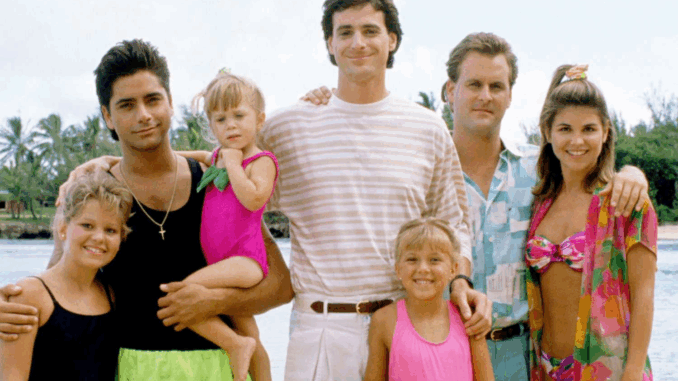
The Recast That Left a Lump in the Throat
Picture this: you’re settled into your favorite sitcom, Full House, watching the Tanner family navigate life when suddenly, Danny’s mom—a beloved character—returns… but played by someone else. No warning, no closure. That’s exactly what happened in Season 3’s “Granny Tanny” when Doris Roberts stepped in for Alice Hirson. On their rewatch podcast How Rude, Tanneritos!, stars Jodie Sweetin and Andrea Barber didn’t hold back. “I did not connect,” Sweetin confessed. This recast wasn’t just a minor change—it reshaped how the cast felt about the episode and the character.
The Charm of Claire: Original vs. Recast
Alice Hirson’s Warmth
Alice Hirson introduced Claire Tanner in Season 1 as a kind, maternal presence—a grandmother figure fans loved. Sweetin remembers that “original Claire felt like Danny’s mom.”
Doris Roberts’ Different Vibe
Years later, Doris Roberts appeared on-screen as Claire in Season 3. Known for her sharp wit and Emmy awards, Roberts was unquestionably talented—but both Sweetin and Barber agreed her portrayal felt “overbearing and pushy,” lacking the warmth they’d come to expect.
Jodie Sweetin’s Honest Take
Sweetin didn’t sugarcoat it on How Rude, Tanneritos! “I did not connect,” she said. The character felt colder, more distant, and lost the nurturing tone Hirson originally brought. The shift was jarring.
Andrea Barber Chimes In
Barber echoed Sweetin’s discomfort. She admitted it was “hard to put into words,” but the chemistry she and Sweetin felt with the first Claire simply wasn’t there with Roberts.
Was It About the Actor or the Chemistry?
To be clear: neither Sweetin nor Barber blamed Doris Roberts. They acknowledged her talent. But they felt the casting decision prioritized star power over compatibility. As Barber commented: “I wonder if [Hirson] wasn’t available or they just thought, ‘Oh, Doris Roberts!’
Why Recasting Happens (Even in Beloved Shows)
Recasting can stem from multiple issues:
-
Scheduling conflicts
-
Creative choices
-
Ratings pressure
In this case, the show likely wanted a familiar face—someone with name recognition to draw in viewers. But even strong actors don’t always mesh with existing dynamics.
The Impact of Misaligned Recasters
1. Fractured Emotional Tone
A sudden change can break immersion and reduce the emotional resonance of scenes.
2. Confused Audience Reception
Viewers grow attached to specific portrayals; disruptions can feel like betrayal.
3. Cast Discomfort
Actors sense when something’s off, and that discomfort seeps into performances.
Why Did the Showrunners Recast Claire?
Network executives probably saw Roberts as a legacy actress—a household name. That credibility can boost ratings or lend weight to a storyline. But without ensuring chemistry with the Tanner cast, the result felt forced.
Lessons Learned: Putting Chemistry First
Sometimes a thrill casting—a big name—backfires without genuine rapport. In ensemble shows centered on family, chemistry isn’t optional—it’s essential.
Other Recast Moments That Mattered
-
Danny Tanner himself: John Posey played him in the unaired pilot before Bob Saget took over. Fans struggle to imagine otherwise.
-
Michelle Tanner: Mary-Kate and Ashley Olsen didn’t return for Fuller House, and no recast has fully satisfied fans.
These stand-out examples show just how much hinge on consistent casting.
What the Audience Felt
Recasting feels personal to viewers—they’ve invested in the characters. A misstep can break that connection instantly.
In Full House, the sudden shift with Claire didn’t just alter one character—it shifted the tone of family warmth at the show’s core.
Could It Have Been Handled Better?
-
Written Re-Entry: A line acknowledging Claire felt different could have helped.
-
Chemistry Tests: On-camera auditions with Jodie Sweetin and Andrea Barber might’ve helped cast the right replacement.
-
Wait and Return: If Hirson was just unavailable temporarily, scripts could’ve left Claire off-camera until she returned.
The Bigger Picture: Casting Matters More Than You Think
On ensemble sitcoms, each character fills a unique role. A grandma, a dad, a quirky friend—it’s like a puzzle. One piece doesn’t just drop in—you feel it.
The anecdote from Full House reminds us how easily good intentions can backfire when chemistry isn’t considered.
Recasting Done Right: When It Doesn’t Hurt the Show
Not all recasts flop. Some work when:
-
The character isn’t central
-
The recaster matches the original’s essence
-
The change is explained or eased in
But for Full House, Claire Tanner was both vital and beloved—so her recast became noticeably jarring.
A Recast Doesn’t Equal a Bad Actor
Both Sweetin and Barber praised Doris Roberts. Their disconnect wasn’t about her skill, but about the shifting emotional landscape. It’s a reminder: even great actors need context, timing, and synchronicity to land.
Conclusion: A Toddler’s Lesson in Ensemble Dynamics
That moment when Grandma sounded “off” taught Full House fans—and the cast—a big lesson. Recasting isn’t just swapping faces; it reshapes emotions, relationships, and even legacy. For Sweetin and Barber, Claire’s warmth defined Danny’s mom. Once that shimmer was gone, they—and we—felt it too.
FAQs
1. Who was the original Claire Tanner in Full House?
Alice Hirson introduced Claire in Season 1 with a warm, nurturing presence.
2. Why did they recast her in Season 3?
Likely due to scheduling conflicts and a desire to attach a high-profile actress—Doris Roberts—but it didn’t suit the show’s tone.
3. What did Jodie Sweetin say about the recast?
She admitted, “I did not connect” with the new portrayal and felt it felt overbearing rather than maternal.
4. Does Doris Roberts get blamed?
No—Sweetin and Barber praised her talent but felt the casting choice didn’t align with their vision of Claire.
5. Did the recast hurt the episode?
For the cast, yes—it made the episode feel disjointed. But fans who revisit it might judge the performance and context differently.
